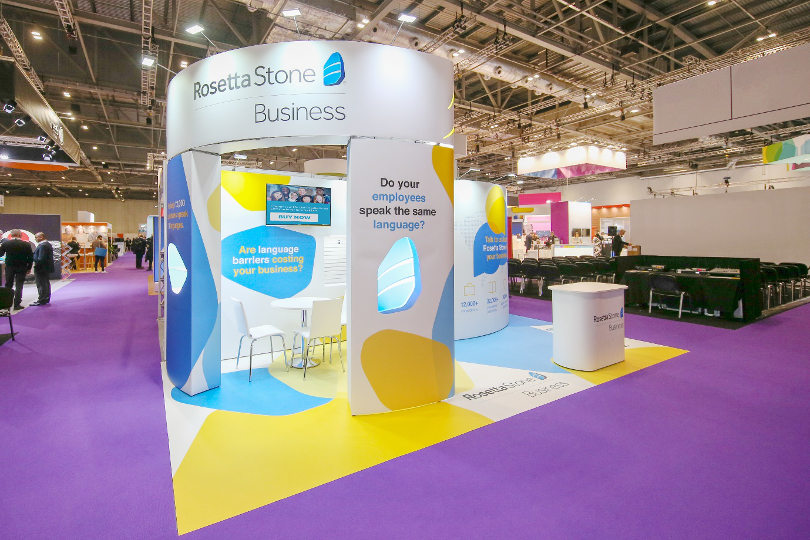We are all guilty of making mistakes when it comes to grammar, but the world of marketing can be an unforgiving place when it comes to such errors.
You might think the odd error is nothing to call the grammar police over, but you’d be wrong to be flippant when it comes to these oversights.
Failure to use correct grammar in your marketing material, on your website, or even on your exhibition stand can not only look sloppy and unprofessional, it can lose you business.

According to a study by Global Lingo, 59 % of people questioned said they would not use a business that had obvious grammatical or spelling mistakes on its website or marketing material. And who could blame them? If a company doesn’t care enough to correct errors in their promotional content, why should anyone trust them?
You might think that with a certain auto-correction site (you know the one we’re talking about) you don’t need to worry too much about checking typos. But this would be misguided.
That’s not to say these applications don’t have their uses, it’s just you can’t rely on them 100%. If the meaning of your content is unclear, then it won’t get picked up or is unlikely to get auto-corrected properly.
Whether it be your website or your exhibition stand, you only have a short amount of time to make a good impression on a potential client. If they spot obvious grammatical errors, then it’s not only going to place you in a bad light, there’s a strong chance you will lose their business.
At Quadrant2Design, we are proud to have some of the most rigorous quality control checks in the exhibition design industry by doing everything in-house. Unlike other exhibition companies, we do not take risks by sub-contracting out any aspect of your exhibition stand to third parties. And as we pre-build every stand before it leaves our premises, you can be sure every marketing message on your exhibition stand will be spelt correctly and grammatically correct before your show.

Below we have listed the top embarrassing grammar mistakes in marketing and how you can avoid them . . .
1. Mixing Up Your & You’re
One of the most common mistakes many businesses, including large well-known companies, make is mixing up “you’re” and “your”. And although the difference between these two words is actually straightforward, that doesn’t stop many of us getting them wrong.
“Your” is the possessive form of “you”. There are only two things you need to remember about this word: it is an adjective and it is possessive. As it is an adjective it can only be used before a noun or a pronoun. And as it is possessive it shows who the noun belongs to: the person you are addressing.
- Our expert will answer all your questions (noun) about pensions and savings.
- Speak to our advisors before buying your next house (noun).
“You’re” is a contraction for (or short way of writing) you are, and can ONLY be used for this purpose. The apostrophe in the middle means it stands for a missing letter.
- You’re late for the meeting.
- Contact me when you’re in London.
If you’re not sure if “your” is the correct word to use in the sentence, check to see if there is a noun after it. If not, then you probably need to use “you’re”.
If you’re not sure whether to use “you’re” simply ask yourself if you can substitute this word with “you are”. If it still makes sense, use “you’re”. If not, use “your”.

2. The Greengrocer’s Apostrophe
Apostrophes! The one everyone dreads, and it’s easy to see why. Considering how many different ways apostrophes can be employed, it is hardly surprising how often they are misused.
Yep, apostrophes are used incorrectly all the time, in blog posts, press releases, and even on exhibition stands. But incorrect use of apostrophes won’t just create a bad impression of your business, they can also change the meaning of the entire sentence.
And as effective marketing is all about communicating your message, getting this wrong can have serious implications for your brand.
The most common error made in business is using an apostrophe to make a word plural. Known as the “greengrocer’s apostrophe”, we see this embarrassing mistake on shop signs all the time. If you want to make a word plural, you simply add an “s” on the end and leave it at that. No apostrophe is needed.
- We offer workable solutions = CORRECT
- We offer workable solution’s = WRONG
- We need to find more clients = CORRECT
- We need to find more client’s = WRONG
The ONLY time an apostrophe can be added with an “s” to the end of a noun is to indicate possession.
- John’s laptop = CORRECT
- Johns laptop = WRONG
- The engineer’s contract = CORRECT
- The engineers contract = WRONG
But what happens to the apostrophe when it is needed to signify possession for more than one person? In this case, the apostrophe has to go after the “s”:
- The dogs’ toys = the toys belong to MORE than one dog.
- The dog’s toys = the toys belong to ONLY one dog.
This is a clear example of how an apostrophe in the wrong place can alter the meaning of what you’re trying to say. So, it is important to be careful with this. There’s no getting around the fact that apostrophes matter.

3. Mixing Up It’s & Its
While we’re on the subject of apostrophes, let’s look at another combination that often confuses people: “it’s” and “its”.
“It’s” is simply a contraction (shortened version) of “it is” or “it has”, and should only be used when these words can be used instead.
- It’s a great article = it is.
- It’s been a successful year for the business = it has.
This is not too hard to grasp, but the use of “its”, without the apostrophe, is where most of us seem to struggle. Don’t worry. It’s a lot simpler than you might think.
“Its” is the possessive form of “it”. This means it is ONLY used to show that something belongs to the thing you’re talking about (it).
- The computer looked as though its power supply had failed
= the power supply belongs to the computer.
- Rome is a beautiful city, and its buildings are magnificent
= the buildings belong to Rome.

4. Mixing up Their, They’re & There
Pronounced exactly the same, you can’t get these words wrong when speaking but in writing it is a very different matter.
Mixing these up has given rise to a number of silly mistakes in signs, articles and all kinds of marketing content. So let’s take a look at the key rules when it comes to using “their”, “there”, and “their” so you can avoid falling into the traps suffered by the poor writers of these embarrassing grammar mistakes!
Their is the possessive form of they, which means it is used to show ownership or belonging. If something belongs to them, it is their item.
- That is their exhibition stand.
- Their company is based in Berlin.
They’re is a shortened version of “they are“, and should ONLY be used in place of these two word.
- They’re very interested in the project.
- They’re looking forward to the meeting.
“There” can be a bit more complicated. If you’re talking about a place or location, then you need to use “there”. One way to remember this is that it means the opposite of here – meaning “in that place”, not here.
- We’ll be there soon.
- He’s sitting over there.
- We went there because it has a nice beach.
There can also be used as a pronoun to show that something exists or going to happen.
- There are a lot of opportunities for our business.
- There is a big meeting today.

5. Misuse of the Passive Voice
Although it’s not easy to write in the passive voice, for some reason it is commonly misused in marketing. Many businesses will use the passive voice thinking it makes them sound more intelligent. It doesn’t, it just sounds confusing.
But what is the passive voice and how can you avoid it in your writing? Passive voice happens when you have an object as the subject of the sentence, as opposed to the person or thing doing the action.
Let’s look at a very simple example . . .
- The ball was kicked by the boy (passive sentence).
This sounds unnatural and weird, doesn’t it? In this sentence the boy is doing the action and therefore should be the subject not the object, so it reads . . .
- The boy kicked the ball (active sentence).
This might seem obvious, but you’d be surprised at how often the passive voice is used in articles and press releases.
- New cars will be showcased at the motor show by BMW (passive).
- BMW will showcase their new cars at the motor show (active).
No matter how embarrassing and cringe-worthy these mistakes might be, they can seriously damage your brand if you fail to correct these details in your marketing material.
Yes, we’re only human and even the most adept of writers and grammar experts can be prone to mistakes. But there are some basic actions you can take to avoid the possibility of your business getting attention for the wrong reasons.
If you’re responsible for writing content for marketing campaigns then you should at least familiarise yourself with the basic rules of grammar. As we have seen, placing apostrophes in the incorrect position or misusing the passive voice, can have a negative impact on your brand.
Even if you’re confident about your English skills, it is important to get someone else to proofread your work. Proofreading your own work is difficult and, as you are so close to it, it can be easy to miss silly mistakes.
Being aware of spelling and grammar isn’t about being a “grammar Nazi”, it’s about making sure your business creates the right impression, and your marketing messages are communicated effectively.







